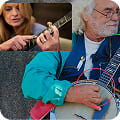Qbert Skratch University
Preview this school
Master the Instrument with DJ
Each lesson builds on the last, taking you from zero to hero!
DJ Qbert is the world ambassador of the DJ as a musician and widely considered to be one of the most influential DJs of all time. Growing up in San Francisco, Qbert gained worldwide recognition for his ability to amaze audiences with his turntable skills and later pioneered performing as a turntable band. A former DMC World Champion, he has long been sought out by equipment companies to help develop innovative products for DJs. Aside from releasing countless products designed for turntable musicians specifically, he was the first to develop an all in one turntable and mixer combination, the QFO, which sparked an explosion of products that catered to turntable musicians. As a recording artist, Qbert has released two concept albums which showcase his continued evolution in turntable music.
Battles
Training Dojo
<p>In this section, you can have call and response sessions with experienced skratch djs. They'll skratch the questions, and you skratch the answers. Here, you can try to copy them or just freestyle. Try out the skratches you've learned and put them together in your own way. It's that easy!</p><p>When you get better, you can post your own call and response "sessions" for the training dojo so that others can skratch along with you too!</p>
Setup & Gear
Helpful Hints
Get Personal Feedback with Video Exchange
Get custom video lessons from your instructor by sending a video of your playing.
How It Works?

1. Submit Your Video
Record and upload directly through our platform. No technical skills required.

2. Get Expert Feedback
Receive personal video responses from DJ Qbert with tips to improve!

3. Learn from Community
Browse exchanges from other students to learn from their questions.
About Qbert Skratch University
DJ Qbert is the world ambassador of the DJ as a musician and widely considered to be one of the most influential DJs of all time. Growing up in San Francisco, Qbert gained worldwide recognition for his ability to amaze audiences with his turntable skills and later pioneered performing as a turntable band. A former DMC World Champion, he has long been sought out by equipment companies to help develop innovative products for DJs. Aside from releasing countless products designed for turntable musicians specifically, he was the first to develop an all in one turntable and mixer combination, the QFO, which sparked an explosion of products that catered to turntable musicians. As a recording artist, Qbert has released two concept albums which showcase his continued evolution in turntable music.
About DJ Qbert
DJ Qbert is the world ambassador of the DJ as a musician and widely considered to be one of the most influential DJs of all time. Growing up in San Francisco, Qbert gained worldwide recognition for his ability to amaze audiences with his turntable skills and later pioneered performing as a turntable band. A former DMC World Champion, he has long been sought out by equipment companies to help develop innovative products for DJs. Aside from releasing countless products designed for turntable musicians specifically, he was the first to develop an all in one turntable and mixer combination, the QFO, which sparked an explosion of products that catered to turntable musicians. As a recording artist, Qbert has released two concept albums which showcase his continued evolution in turntable music.
What students are saying!
OG 100 Member Review
As one of the 'Original 100' members of QSU, Qbert's school offers so much for any level of DJ. His easy-going style and laid-back way of teaching make even the most difficult skra...
👍
👍

